SEO
Lead Generation: How To Get Started

Today’s consumers have an almost limitless amount of information at their fingertips. Podcasts, videos, blog posts, and social media – are just a few of the sources that can drive them toward one brand over another.
If it’s your job to attract these potential customers, you know the struggles of generating high-quality leads.
In this piece, we’ll take a closer look at lead generation, discussing the different types of leads you could attract and providing some strategies and examples for lead gen that you can put to use right away.
What Is Lead Generation?
Lead generation is a marketing process of capturing potential consumers who show interest in your product or service.
The goal is to connect with people early in the buying process, earn their trust and build a relationship so that, when they’re ready to make a purchase, they buy from you.
But lead generation also serves secondary objectives, including building brand awareness, collecting customer data, and fostering brand loyalty.
With this in mind, it’s important to remember that not everyone who visits your store or website is a lead.
That’s why successful lead gen goes after specific targets, using a variety of platforms and strategies including:
- Landing pages – Using a tracking pixel, landing pages collect information about visitors you can later use to target them for sales.
- Email – Email is a great lead generation tool because the recipients will have opted in, which means they’re already familiar with your brand.
- Social media – With unmatched opportunities for engagement, your social media accounts are a great way to encourage your targets to take action.
- Blogs – A great way to establish authority and provide value, blogs are also a great place to promote specific offers.
- Live events – When it comes to qualifying leads, live events are a great way to meet your target audience and quickly identify the ones more likely to make a purchase.
- Coupons and other promotions – Offering a discount or free item is a great way to encourage targets to provide their contact information.
What will ultimately work best for you will depend on your niche and your audience.
As you experiment with different lead generation strategies, you may find one more successful than the others. This means you should probably make that channel your priority, whereas others may not be of any use at all.
But we’ll get to all that later.
First, let’s talk about leads.
The Different Types Of Leads
Sales is the engine that drives any business. Without sales, there’s no revenue. Without revenue, there’s no business. So, it’s kind of important.
But it’s a massive field. The approach a medical monitoring sensor salesperson takes is going to be very different from a used car salesman.
But both of them – and every other sales professional for that matter – have one thing in common: they need to spend most of their time pursuing the people who are most likely to buy.
In general, leads fall into seven categories:
- Hot Leads – These leads are ready to convert. They are qualified and interested in your offering, and are the most likely to convert to a sale. For example, this might be the purchasing director who has had several conversations with you and received a product demo. They have purchasing authority and a timeline.
- Cold Leads – These are potential customers who may be unfamiliar with your brand or offering. As of yet, they have shown no interest in what you’re selling. Generally speaking, these are the hardest leads to convert to sales.
- Warm Leads – A middle ground between the two previous types of leads, these are people who are familiar with who you are and what you offer. They’re the type who watch your videos or read your blogs, but haven’t contacted you directly. Your goal is to warm them up into hot leads.
- Information Qualified Leads (IQLs) – This is the kind of lead who has already shown some interest in your company and has followed a call to action. Maybe they signed up for your email newsletter or filled out a lead generation form. They are often looking for more information and will react positively to a nurturing campaign.
- Marketing Qualified Leads (MQLs) – MQLs are one step further down the pipeline from IQLs. They are actively searching for a solution that fits their needs, and are trying to discover if yours is the right fit. These are the types of leads who will download your whitepapers, watch your videos, and attend your corporate seminars.
- Sales Ready Leads (SRLs) – Sometimes called “accepted leads,” these are the bottom-of-the-funnel leads who are almost ready to pull the trigger on a purchase. It’s important to understand their budgets, purchasing authority, needs, and timeframe.
- Sales Qualified Leads (SQLs) – These leads are ready to buy and should be in communication with your sales team. They are considered very hot, however, you should be aware that they are likely still considering some of your competitors.
The Lead Generation Process
As you have probably gathered by this point, lead generation is a multiple-step process.
Yours will vary, depending on whether you’re focusing on inbound or outbound generation – but both should follow a similar pathway.
Step 1: Do Your Research
Before you start trying to collect leads, you need to gather as much information as possible about your target audience. You want to know not just who they are, but where they live, what’s important to them, and most importantly, what their pain points are, particularly those that are the most pressing.
It’s often a good idea to create customer personas, in which you define the demographics, budget, and needs of typical customers. You may want to consider social habits, professional experience, and even psychological traits.
Once you know who you’re going after, it’s time to identify where they are. Are they active on Facebook, or more likely to respond to an email? Again, this will vary depending on your specific circumstances.
This is also the stage where you should check out the competition. What are they doing? What differentiates your offering from theirs? And most importantly, why is it better?
Step 2: Create Great Content
By now, you should know what needs your offering fills for your potential customers. Use this information to create content that solves it.
Your choice of medium will affect your content format. For example, videos work great on social media, but you can’t embed them in an email.
Likewise, if you’re going after your target audience on Twitter, your lengthy blogs are going to need to be linked to, or at the very least truncated.
Never forget your focus is on adding value. Each piece of content you create should serve a specific purpose, whether that’s educating your audience about your offering, building brand awareness or promoting a sale.
Step 3: Develop A Lead Generation Database
You can have the hottest leads on the planet, but they won’t do you a bit of good if you don’t handle them the right way.
You should create and use a lead database where you can record, study, filter, and segment your potential customers.
Ideally, you’ll want to get an automated CRM system to dramatically reduce the labor involved with this.
Most of these will allow you to tag leads based on the type and how hot they are. This allows your sales team to work through their lists in a more efficient manner, dedicating the most attention to those with the biggest chance of converting.
Step 4: Qualify And Score Leads
Not all leads are going to be in the same place in the sales funnel. Some will be ready to buy today, while others may just be getting an idea of what’s out there.
You need to adjust your approach based on this.
Most companies use a lead scoring system of 1-100, which indicates approximately where the lead is in the customer journey. They are assigned points based on their actions, with more serious actions resulting in more points.
For example, following your Facebook page could be worth 10 points, filling out a “Request a demo” form might be worth 20, and opening and reading an email could be 5. If a lead does all three of these, their lead score would be 35.
These numbers will give you a general idea of where they are from the following stages:
- New leads, who have just made initial contact.
- Working leads, with whom you have had contact and initiated a conversation.
- Nurturing leads, who are not interested in buying right now, but might in the future.
- Unqualified leads, who are not interested in your offering. These are sometimes called “dead leads.”
- Qualified leads, or those who want to do business with you.
Obviously, you should focus more time and energy on the leads that have a higher probability of converting.
Lead Generation Strategies And Examples
The ways you can generate leads are practically endless, but in this section, we’ll discuss some of the more common strategies you can employ, plus give you examples of them at work.
Content Marketing
Content marketing is the practice of creating engaging and informative content that provides value for leads and customers, thereby generating interest in a business.
This can span both traditional and digital marketing, and is an important part of any successful marketing strategy. It can include things like newsletters, podcasts, videos, and social media.
You can use content marketing for any stage of the sales funnel, from growing brand awareness with timely blogs, creating demand or demonstrating thought leadership with white papers, driving organic traffic via SEO, building trust, and earning customer loyalty.
To make the most of yours, offer many opt-in opportunities and make them more enticing by adding discounts, guides, or something of value in exchange.
Email Marketing
Email remains a popular choice for lead generation for a good reason: it works.
A study by Mailchimp found 22.71% of marketing emails were opened, with some industries seeing even higher rates.
Whether you’re sending out a monthly newsletter or a cold outreach email to a potential prospect, email remains one of your best bets for generating new leads.
One of the more cost-effective means of generating leads, email marketing also allows you to segment your targets with customized content that promotes maximum engagement.
Another reason email marketing is a favorite for so many organizations is that it provides incredible opportunities for tracking. A quality CRM will give you a lot of useful data, including open rate, engagement time, and subscriber retention, allowing you to fine-tune your campaigns.
Social Media Marketing
Almost everyone is on social media these days, which makes it the ideal place to hunt down leads.
Social media platforms not only allow you to directly interact with your followers, but they also let you create advertising targeted at highly specific audiences.
Interaction is simplified thanks to multiple user-friendly CTAs like Instagram Stories’ skip option and truncated URLs on Twitter.
Social media is also a great place to run contests or share gated content.
You can use paid ads like the one above to target new leads, share content that will generate them organically, or ideally, a mix of both.
Coupons, Discounts, And Free Trials
If you’re like many people, you may be reluctant to provide your email address to businesses in case they start spamming your inbox.
As a business, however, this can be a problem.
The way to overcome this trepidation is to offer people something of value in return for their contact information.
A risk-free trial or discount code is a powerful tool for overcoming sales barriers. And once a target has tried your offering, you can retarget them with additional offers to encourage a sale.
Give them a free gift, offer a coupon, or allow them to take your product for a test drive, and you’ll find many more people willing to give you their info.
 Screenshot from author, January 2023
Screenshot from author, January 2023Online Ads
Display advertisements are videos and images that pop up as you’re browsing websites, apps, and social media.
They, along with paid search and PPC, are a great way to reach your intended customers where they are.
Display ads are particularly useful for targeting leads across the buyers’ journey, as well as promoting awareness and sales, promotions, or new products.
 Screenshot from Google, January 2023
Screenshot from Google, January 2023Remarketing ads are a great way to reengage leads who have stopped short of a purchase, while non-intrusive native ads are perfect for extending your content marketing efforts.
Referral Marketing
A great way to find new leads is to let your existing customers find them for you. Encourage them to write reviews or recommend friends in return for a discount or something else of value.
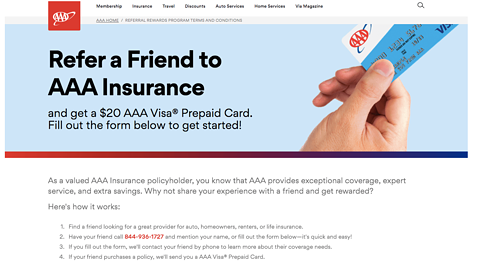 Image from AAA Insurance, January 2023
Image from AAA Insurance, January 2023This is an excellent way to fill your funnel of leads – and make more sales. Referrals and online reviews give you an authenticity and trust level that no in-house marketing campaign can ever duplicate.
Did you know that when shopping online, more than 99.9% of people read reviews? Or that 94% of consumers acknowledged positive reviews made them more likely to support a business? And that’s not even including the power of personal recommendations from friends and family.
Referral marketing is a great tool for lead generation because it presents your brand in a positive light to more people.
Best Practices For Lead Generation
To ensure you’re getting the most out of your lead generation efforts, keep these tips in mind:
Use Your Data
You likely have a lot of information about leads and the types of strategies that work for them already at your fingertips.
Gather yours by looking at previous pieces that have worked well, whether it’s blogs that get a lot of reads, emails that have a high open-rate, or display ads that bring in a lot of traffic.
Look for general themes or things you did differently on high-performers. This will give you insight into the kind of things that resonate with your audience.
Be Consistent With Messaging
Make sure it’s very obvious to any web visitor or email recipient what action they should take next. Offer them a reason to click your links and keep your messaging clear and consistent.
You should maintain the same tone of voice across channels as you move prospects through the sales funnel. Remember, you’re not just interested in capturing data – you’re trying to create a customer.
A/B Testing
Every marketer knows the importance of testing different versions of collateral. This is because, no matter how well something is performing, it could always do better.
You should experiment with different headlines, images, body copy, etc.
Just remember to only test one aspect at once, lest you miss which change made a difference.
And again, don’t forget the opt-ins.
Use The Power Of CRM Technology
To ensure your sales and marketing teams are operating as efficiently as possible, but a lead generation platform to work for you.
The right tool can help you gather information about your targets, monitor their behavior on your website and identify what’s driving them to you.
Armed with this data, you can then optimize your pages and campaigns to better target your audience.
Create Enticing Offers At Every Stage
People at different stages of the purchasing journey want different things.
Someone who is just curious about seeing what’s out there isn’t likely to respond to a free demo offer, but someone who is further along the funnel might.
Make sure you’re offering something for every buying stage and that you have clear CTAs throughout your materials.
Integrate Social Media
Social media is the ideal platform for initiating conversations and interactions with leads at all stages.
While many marketers typically think of it as primarily for top-of-funnel targeting, by strategically using proven offers and other things of value, you can also go after those leads who are closer to making a purchase.
Clean Up Your Landing Pages
Users want information presented to them in a clean, easy-to-understand manner. No one is trying to read “War and Peace” to find a new vending machine supplier.
Put your important information at the top, and make it clear where visitors can input their information to contact you or get content.
Use Your Partners
Co-marketing is a great way to generate new leads because it allows you to piggyback on the efforts of partner companies.
Create mutually beneficial offers and you’ll spend the word about your brand to a larger audience, which will attract new leads.
Bring Your Sales Team In
Marketers prime the pump, but sales drives the action. Make sure to loop your sales team into the lead generation process early and often.
They will likely have personal insight into what works best to move targets along the purchasing path.
This will also ensure you remain on the same page as far as what terms mean.
Remarket, Remarket, Remarket
Almost no one makes a purchase on first contact, particularly in B2B sales. That makes remarketing an important arrow for your quiver.
It helps turn bouncers into leads and abandoners into customers – and it amplifies all your other marketing activities.
Make Lead Generation A Priority
No one ever said it was easy to find, score, and qualify leads, but it’s an important part of ensuring the growth and financial health of your business.
Nurturing customers and potential customers is hard work. But without it, you’ll struggle to make new sales.
This piece only covered lead generation from a high level, but hopefully, it has equipped you with some strategies you can employ to attract new leads and nurture existing ones.
If you only take a single thing away from this make it this: Put most of your efforts into higher-quality leads, because they’re the ones who are most likely to make a purchase.
And remember – lead generation is an ongoing process. You’re not going to see results overnight, but if you put in the work, you’ll start to generate the results you want.
Happy hunting.
More resources:
Featured Image: Andrey_Popov/Shutterstock
SEO
Google Confirms Links Are Not That Important

Google’s Gary Illyes confirmed at a recent search marketing conference that Google needs very few links, adding to the growing body of evidence that publishers need to focus on other factors. Gary tweeted confirmation that he indeed say those words.
Background Of Links For Ranking
Links were discovered in the late 1990’s to be a good signal for search engines to use for validating how authoritative a website is and then Google discovered soon after that anchor text could be used to provide semantic signals about what a webpage was about.
One of the most important research papers was Authoritative Sources in a Hyperlinked Environment by Jon M. Kleinberg, published around 1998 (link to research paper at the end of the article). The main discovery of this research paper is that there is too many web pages and there was no objective way to filter search results for quality in order to rank web pages for a subjective idea of relevance.
The author of the research paper discovered that links could be used as an objective filter for authoritativeness.
Kleinberg wrote:
“To provide effective search methods under these conditions, one needs a way to filter, from among a huge collection of relevant pages, a small set of the most “authoritative” or ‘definitive’ ones.”
This is the most influential research paper on links because it kick-started more research on ways to use links beyond as an authority metric but as a subjective metric for relevance.
Objective is something factual. Subjective is something that’s closer to an opinion. The founders of Google discovered how to use the subjective opinions of the Internet as a relevance metric for what to rank in the search results.
What Larry Page and Sergey Brin discovered and shared in their research paper (The Anatomy of a Large-Scale Hypertextual Web Search Engine – link at end of this article) was that it was possible to harness the power of anchor text to determine the subjective opinion of relevance from actual humans. It was essentially crowdsourcing the opinions of millions of website expressed through the link structure between each webpage.
What Did Gary Illyes Say About Links In 2024?
At a recent search conference in Bulgaria, Google’s Gary Illyes made a comment about how Google doesn’t really need that many links and how Google has made links less important.
Patrick Stox tweeted about what he heard at the search conference:
” ‘We need very few links to rank pages… Over the years we’ve made links less important.’ @methode #serpconf2024″
Google’s Gary Illyes tweeted a confirmation of that statement:
“I shouldn’t have said that… I definitely shouldn’t have said that”
Why Links Matter Less
The initial state of anchor text when Google first used links for ranking purposes was absolutely non-spammy, which is why it was so useful. Hyperlinks were primarily used as a way to send traffic from one website to another website.
But by 2004 or 2005 Google was using statistical analysis to detect manipulated links, then around 2004 “powered-by” links in website footers stopped passing anchor text value, and by 2006 links close to the words “advertising” stopped passing link value, links from directories stopped passing ranking value and by 2012 Google deployed a massive link algorithm called Penguin that destroyed the rankings of likely millions of websites, many of which were using guest posting.
The link signal eventually became so bad that Google decided in 2019 to selectively use nofollow links for ranking purposes. Google’s Gary Illyes confirmed that the change to nofollow was made because of the link signal.
Google Explicitly Confirms That Links Matter Less
In 2023 Google’s Gary Illyes shared at a PubCon Austin that links were not even in the top 3 of ranking factors. Then in March 2024, coinciding with the March 2024 Core Algorithm Update, Google updated their spam policies documentation to downplay the importance of links for ranking purposes.
The documentation previously said:
“Google uses links as an important factor in determining the relevancy of web pages.”
The update to the documentation that mentioned links was updated to remove the word important.
Links are not just listed as just another factor:
“Google uses links as a factor in determining the relevancy of web pages.”
At the beginning of April Google’s John Mueller advised that there are more useful SEO activities to engage on than links.
Mueller explained:
“There are more important things for websites nowadays, and over-focusing on links will often result in you wasting your time doing things that don’t make your website better overall”
Finally, Gary Illyes explicitly said that Google needs very few links to rank webpages and confirmed it.
I shouldn’t have said that… I definitely shouldn’t have said that
— Gary 鯨理/경리 Illyes (so official, trust me) (@methode) April 19, 2024
Why Google Doesn’t Need Links
The reason why Google doesn’t need many links is likely because of the extent of AI and natural language undertanding that Google uses in their algorithms. Google must be highly confident in its algorithm to be able to explicitly say that they don’t need it.
Way back when Google implemented the nofollow into the algorithm there were many link builders who sold comment spam links who continued to lie that comment spam still worked. As someone who started link building at the very beginning of modern SEO (I was the moderator of the link building forum at the #1 SEO forum of that time), I can say with confidence that links have stopped playing much of a role in rankings beginning several years ago, which is why I stopped about five or six years ago.
Read the research papers
Authoritative Sources in a Hyperlinked Environment – Jon M. Kleinberg (PDF)
The Anatomy of a Large-Scale Hypertextual Web Search Engine
Featured Image by Shutterstock/RYO Alexandre
SEO
How to Become an SEO Lead (10 Tips That Advanced My Career)

A few years ago, I was an SEO Lead managing enterprise clients’ SEO campaigns. It’s a senior role and takes a lot of work to get there. So how can you do it, too?
In this article, I’ll share ten tips to help you climb the next rung in the SEO career ladder.
Helping new hires in the SEO team is important if you want to become an SEO Lead. It gives you the experience to develop your leadership skills, and you can also share your knowledge and help others learn and grow.
It demonstrates you can explain things well, provide helpful feedback, and improve the team’s standard of work. It shows you care about the team’s success, which is essential for leaders. Bosses look for someone who can do their work well and help everyone improve.
Here are some practical examples of things I did early in my career to help mentor junior members of the team that you can try as well:
- Hold “lunch and learn” sessions on topics related to SEO and share case studies of work you have done
- Create process documents for the junior members of the team to show them how to complete specific tasks related to your work
- Compile lists of your favorite tools and resources for junior members of the team
- Create onboarding documents for interns joining the company
Wouldn’t it be great if you could look at every single SEO Lead’s resume? Well, you already can. You can infer ~70% of any SEO’s resume by spying on their LinkedIn and social media channels.
Type “SEO Lead” into LinkedIn and see what you get.
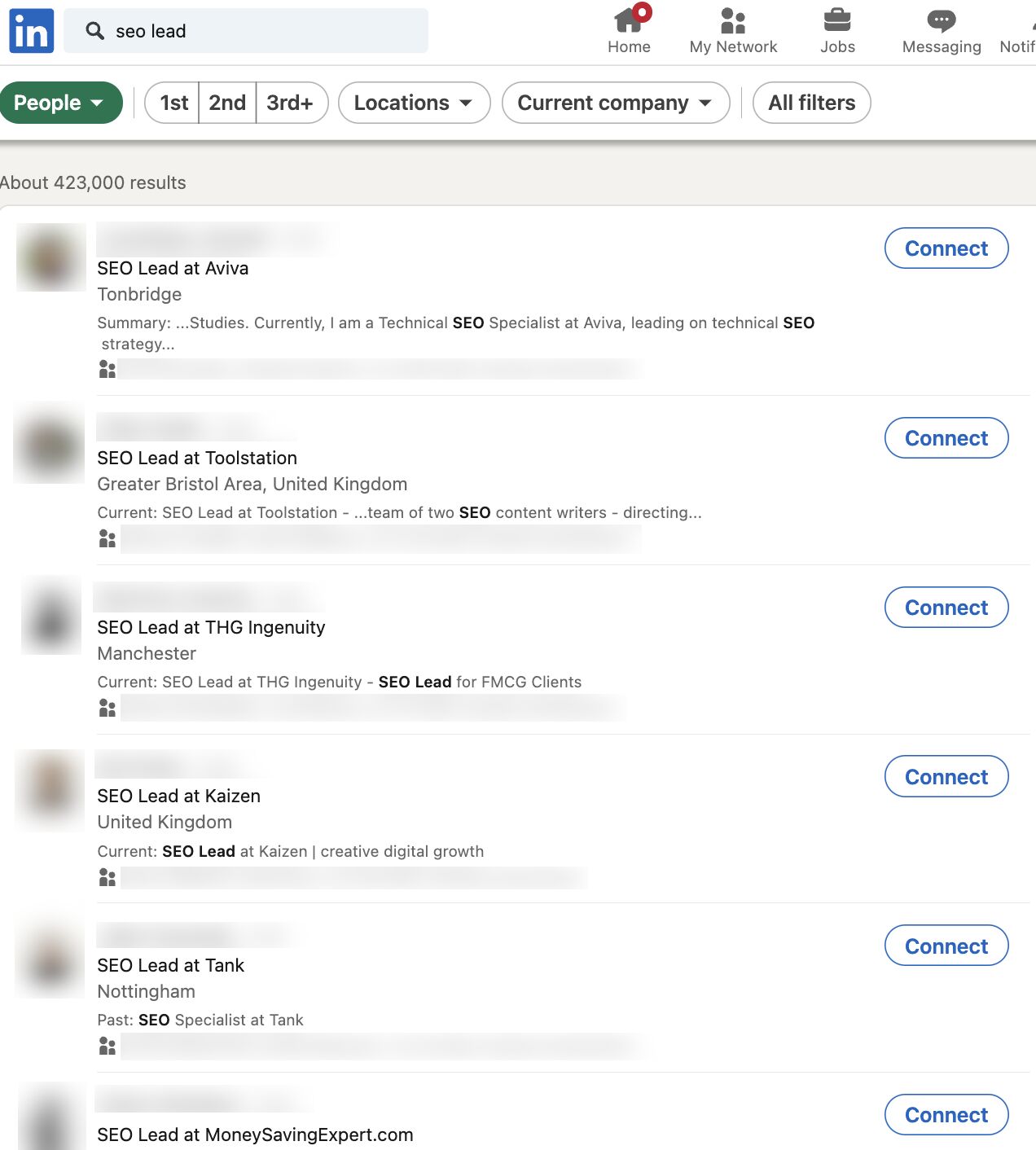
Tip
Look for common career patterns of the SEOs you admire in the industry.
I used this method to understand how my favorite SEOs and people at my company navigated their way from a junior role to a senior role.
For example, when the Head of SEO at the time Kirsty Hulse, joined my team, I added her on LinkedIn and realized that if I wanted to follow in her footsteps, I’d need to start by getting the role of SEO Manager to stand any possible chance of leading SEO campaigns like she was.
The progression in my company was from SEO Executive to Senior SEO Executive (Junior roles in London, UK), but as an outsider coming into the company, Kirsty showed me that it was possible to jump straight to SEO Manager given the right circumstances.


Using Kirsty’s and other SEOs’ profiles, I decided that the next step in my career needed to be SEO Manager, and at some point, I needed to get some experience with a bigger media agency so I could work my way up to leading an SEO campaign with bigger brands.
Sadly, you can’t just rock up to a monthly meeting and start leading a big brand SEO campaign. You’ll need to prove yourself to your line manager first. So how can you do this?
Here’s what I’d suggest you do:
- Create a strong track record with smaller companies.
- Obsessively share your wins with your company, so that senior management will already know you can deliver.
- At your performance review, tell your line manager that you want to work on bigger campaigns and take on more responsibility.
If there’s no hope of working with a big brand at your current job, you might need to consider looking for a new job where there is a recognizable brand. This was what I realized I needed to do if I wanted to get more experience.
Tip
Get recruiters on LinkedIn to give you the inside scoop on which brands or agencies are hiring. Ask them if you have any skill gaps on your resume that could prevent you from getting a job with these companies.
Being critical of your skill gaps can be hard to do. I found the best way to identify them early in my career was to ask other people—specifically recruiters. They had knowledge of the industry and were usually fairly honest as to what I needed to improve.
From this, I realized I lacked experience working with other teams—like PR, social, and development teams. As a junior SEO, your mind is focused 99% on doing SEO, but when you become more senior, your integration with other teams is important to your success.
For this reason, I’d suggest that aspiring SEO Leads should have a good working knowledge of how other teams outside of SEO operate. If you take the time to do this, it will pay dividends later in your career:
- If there are other teams in your company, ask if you can do some onboarding training with them.
- Get to know other team leads within your company and learn how they work.
- Take training courses to learn the fundamentals of other disciplines that complement SEO, such as Python, SQL, or content creation.
Sometimes, employers use skill gaps to pay you less, so it’s crucial to get the skills you need early on…


Examples of other skill gaps I’ve noticed include:
Tip
If you think you have a lot of skill gaps, then you can brush up your skills with our SEO academy. Once you’ve completed that, you can fast-track your knowledge by taking a course like Tom Critchlow’s SEO MBA, or you can try to develop these skills through your job.


As a junior in any company, it can be hard to get your voice heard amongst the senior crowd. Ten years ago, I shared my wins with the team in a weekly group email in the office.
Here’s what you should be sharing:
- Praise from 3rd parties, e.g. “the client said they are impressed with the work this month.”
- Successful performance insights, e.g “following our SEO change, the client has seen X% more conversions this month.”
- Examples of the work you led, e.g. if your leadership and decision-making led to good results, then you need to share it.
At Ahrefs I keep a “wins” document. It’s just a simple spreadsheet that lists feedback on the blog posts I’ve written, the links I’ve earned and what newsletters my post was included in. It’s useful to have a document like this so you have a record of your achievements.
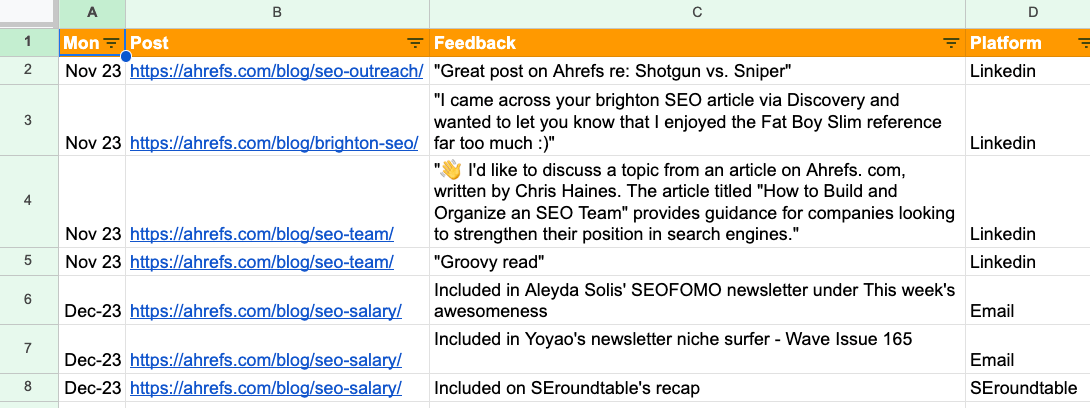

Sidenote.
Junior SEOs sometimes talk about the things “we” achieved as a team rather than what they achieved at the interview stage. If you want the SEO Lead role, remember to talk about what you achieved. While there’s no “I” in team, you also need to advocate for yourself.
One of my first big wins as an SEO was getting a link from an outreach campaign on Buzzfeed. When I went to Brighton SEO later that year and saw Matthew Howells-Barby sharing how he got a Buzzfeed link, I realized that this was not something everyone had done.
So when I did manage to become an SEO Lead, and my team won a prize in Publicis Groupe for our SEO performance, I made sure everyone knew about the work we did. I even wrote a case study on the work for Publicis Groupe’s intranet.
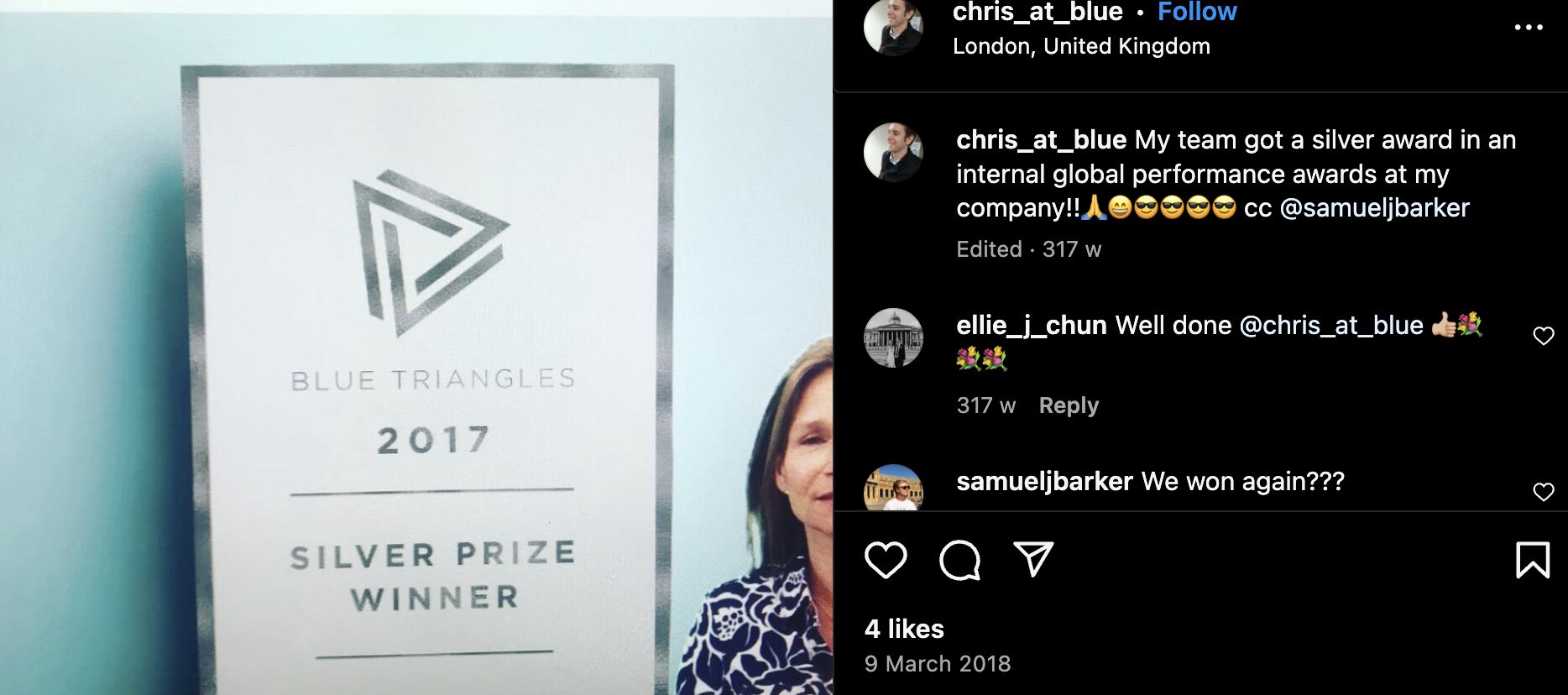

I’ve worked with some incredibly talented people, many of whom have helped me in my career.
I owe my big break to Tim Cripps, Laura Scott, and Kevin Mclaren. Without their support and encouragement, I wouldn’t be where I am today. Even before that, David Schulhof, Jodie Wheeler, and Carl Brooks let me mastermind some bonkers content campaigns that were lucky enough to succeed:


I wasn’t even an SEO Lead at that point, but they gave me the reins and trusted me.
So, how can you find your tribe?
- Speak to recruiters – they might hold the ticket to your next dream job. I spoke to many recruiters early in my career, but only two recruiters delivered for me—they were Natasha Woodford, and Amalia Gouta. Natasha helped me get a job that filled my skill gap, and Amalia helped me get my first SEO Lead role.
- Go to events and SEO conferences, and talk to speakers to build connections outside of your company.
- Use LinkedIn and other social media to interact with other companies or individuals that resonate with you.
Many senior SEO professionals spend most of their online lives on X and LinkedIn. If you’re not using them, you’re missing out on juicy opportunities.


Sharing your expertise on these platforms is one of the easiest ways to increase your chances of getting a senior SEO role. Because, believe it or not, sometimes a job offer can be just a DM away.
Here’s some specific ideas of what you can share:
- Share your thoughts on a trending topic – like the latest Google algorithm update.
- Share what you learned during the course of a campaign.
- Ask the community for their thoughts on a certain topic.
I’ve recently started posting on LinkedIn and am impressed by the reach you can get by posting infrequently on these topics.
Here’s an example of one of my posts where I asked the community for help researching an article I was writing:
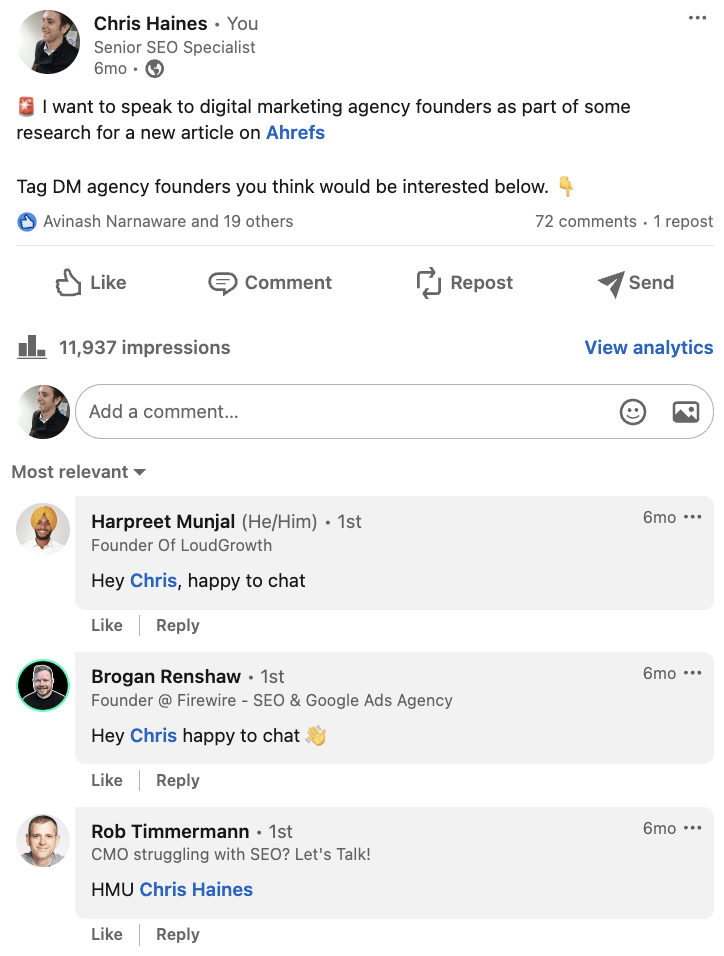

And here is the content performance across the last year from posting these updates.


I’m clearly not a LinkedIn expert—far from it! But as you can see, with just a few months of posting, you can start to make these platforms work for you.
Godard Abel, co-founder of G2, talked on a podcast about conscious leadership. This struck a chord with me recently as I realized that I had practiced some of the principles of conscious leadership—unconsciously.
You can start practicing conscious leadership by asking yourself if your actions are above or below the line. Here are a few examples of above and below-the-line thinking:
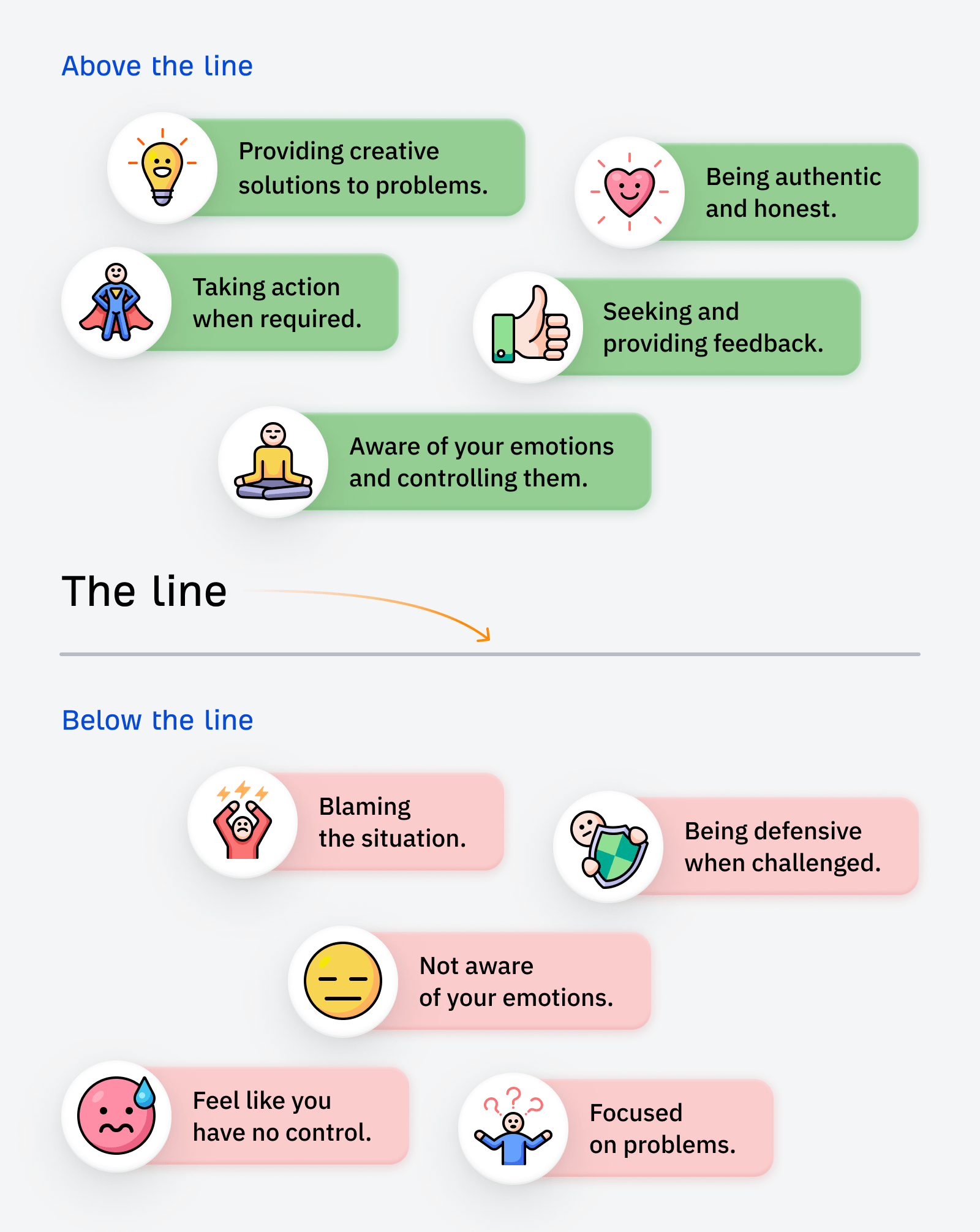

If you want a senior SEO role, I’d suggest shifting your mindset to above-the-line thinking.
In the world of SEO, it’s easy to blame all your search engine woes on Google. We’ve all been there. But a lot of the time, simple changes to your website can make a huge difference—it just takes a bit of effort to find them and make the changes.
SEO is not an exact science. Some stakeholders naturally get nervous if they sense you aren’t sure about what you’re saying. If you don’t get their support early on then you fall at the first hurdle.


To become more persuasive, try incorporating Aristotle’s three persuasive techniques into your conversations.
- Pathos: use logical reasoning, facts, and data to present water-tight arguments.
- Ethos: establish your credibility and ethics through results.
- Logos: make your reports tell a story.


Then sprinkle in language that has a high level of modality:


Some people will be able to do this naturally without even realizing it, but for others, it can be an uphill struggle. It wasn’t easy for me, and I had to learn to adapt the way I talked to stakeholders early on.
The strongest way I found was to appeal to emotions and back up with data from a platform like Ahrefs. Highlight what competitors have done in terms of SEO and the results they’ve earned from doing it.
Sidenote.
You don’t have to follow this tip to the letter, but being aware of these concepts means you’ll start to present more confident and persuasive arguments for justifying your SEO strategies.
When I started in SEO, I had zero connections. Getting a job felt like an impossible challenge.
Once I’d got my first SEO Lead job, it felt stupidly easy to get another one—just through connections I’d made along the way in my SEO journey.
I once got stuck on a delayed train with a senior member of staff, and he told me he was really into Google Local Guides, and he was on a certain high level. He said it took him a few years to get there.
Local Guides is part of Google Maps that allows you submit reviews and other user generated content
When he showed me the app, I realized that you could easily game the levels by uploading lots of photos.
In a “hold my beer” moment, I mass downloaded a bunch of photos, uploaded them to Local Guides and equaled his Local Guide level on the train in about half an hour. He was seething.


One of the photos I uploaded was a half-eaten Subway. It still amazes me that 50,974 people have seen this photo:
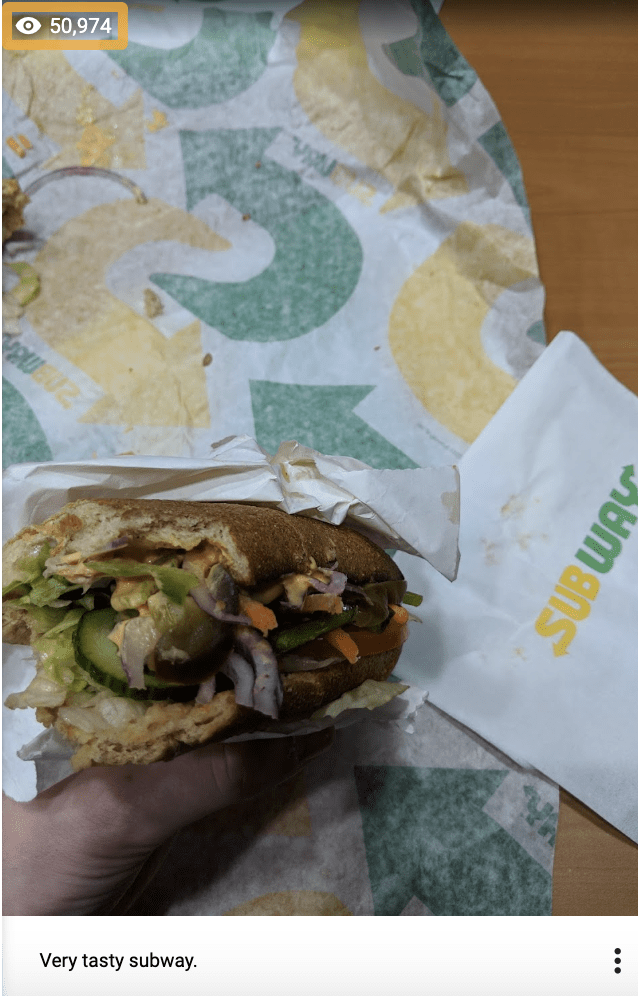

This wasn’t exactly SEO, but the ability to find this ‘hack’ so quickly impressed him, and we struck up a friendship.
The next month that person moved to another company, and then another few months later, he offered me an SEO Lead job.
Tip
Build connections with everyone you can—you never know who you might need to call on next.
Final thoughts
The road to becoming an SEO Lead seems straightforward enough when you start out, but it can quickly become long and winding.
But now armed with my tips, and a bucket load of determination, you should be able to navigate your way to an SEO Lead role much quicker than you think.
Lastly, if you want any more guidance, you can always ping me on LinkedIn. 🙂
SEO
7 Content Marketing Conferences to Attend in 2024
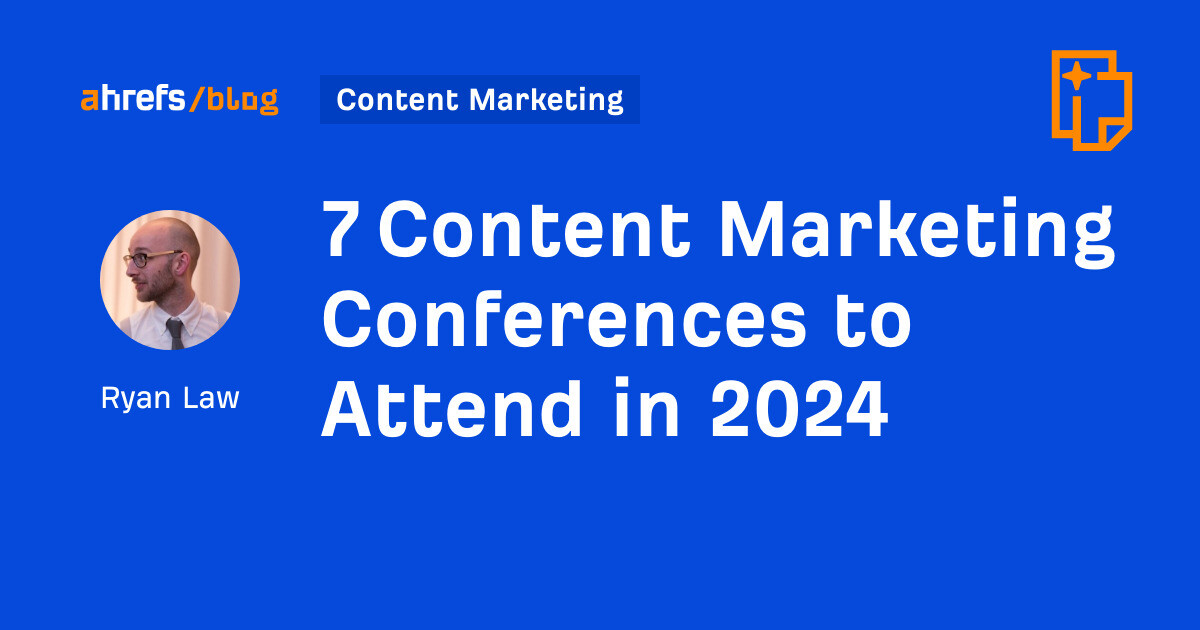
I spend most of my days sitting in front of a screen, buried in a Google Doc. (You probably do too.)
And while I enjoy deep work, a few times a year I get the urge to leave my desk and go socialize with other human beings—ideally on my employer’s dime 😉
Conferences are a great excuse to hang out with other content marketers, talk shop, learn some new tricks, and pretend that we’re all really excited about generative AI.
Without further ado, here are the biggest and best content marketing conferences happening throughout the rest of 2024.
Dates: May 5–7
Prices: from $795
Website: https://cex.events/
Location: Cleveland, OH
Speakers: B.J. Novak, Ann Handley, Alexis Grant, Justin Welsh, Mike King
CEX is designed with content entrepreneurs in mind (“contenpreneurs”? Did I just coin an awesome new word?)—people that care as much about the business of content as they do the craft.
In addition to veteran content marketers like Ann Handley and Joe Pulizi waxing lyrical about modern content strategy, you’ll find people like Justin Welsh and Alexis Grant exploring the practicalities of quitting your job and becoming a full-time content creator.
Here’s a trailer for last year’s event:
Sessions include titles like:
- Unlocking the Power of Book Publishing: From Content to Revenue
- Quitting A $200k Corporate Job to Become A Solo Content Entrepreneur
- Why You Should Prioritize Long-Form Content
(And yes—Ryan from The Office is giving the keynote.)
Dates: Jun 3–4
Location: Seattle, WA
Speakers: Wil Reyolds, Bernard Huang, Britney Muller, Lily Ray
Prices: from $1,699
Website: https://moz.com/mozcon
Software company Moz is best known in the SEO industry, but its conference is popular with marketers of all stripes. Amidst a lineup of 25 speakers there are plenty of content marketers speaking, like Andy Crestodina, Ross Simmonds, and Chima Mmeje.
Check out this teaser from last year’s event:
This year’s talks include topics like:
- Trust and Quality in the New Era of Content Discovery
- The Power of Emotion: How To Create Content That (Actually) Converts
- “E” for Engaging: Why The Future of SEO Content Needs To Be Engaging
Dates: Sep 18–20
Location: Boston, MA
Speakers: TBC
Prices: from $1,199
Website: https://www.inbound.com/
Hosted by content marketing OG HubSpot, INBOUND offers hundreds of talks, deep dives, fireside chats, and meetups on topics ranging from brand strategy to AI.
Here’s the recap video:
I’ve attended my fair share of INBOUNDs over the years (and even had a beer with co-founder Dharmesh Shah), and always enjoy the sheer choice of events on offer.
Keynotes are a highlight, and this year’s headline speaker has a tough act to follow: Barack Obama closed out the conference last year.
Dates: Oct 22–23
Location: San Diego, CA
Speakers: TBC
Prices: from $1,199
Website: https://www.contentmarketingworld.com/
Arguably the content marketing conference, Content Marketing World has been pumping out content talks and inspiration for fourteen years solid.
Here’s last year’s recap:
The 2024 agenda is in the works, but last year’s conference explored every conceivable aspect of content marketing, from B2C brand building through to the quirks of content for government organizations, with session titles like:
- Government Masterclass: A Content Marketing Strategy to Build Public Trust
- A Beloved Brand: Evolving Zillow’s Creative Content Strategy
- Evidence-Based SEO Strategies: Busting “SEO Best Practices” and Other Marketing Myths
Dates: Oct 24–25
Location: Singapore
Speakers: Andy Chadwick, Nik Ranger, Charlotte Ang, Marcus Ho, Victor Karpenko, Amanda King, James Norquay, Sam Oh, Patrick Stox, Tim Soulo (and me!)
Prices: TBC
Website: https://ahrefs.com/events/evolve2024-singapore
That’s right—Ahrefs is hosting a conference! Join 500 digital marketers for a 2-day gathering in Singapore.
We have 20 top speakers from around the world, expert-led workshops on everything from technical SEO to content strategy, and tons of opportunities to rub shoulders with content pros, big brands, and the entire Ahrefs crew.
I visited Singapore for the first time last year and it is really worth the trip—I recommend visiting the Supertree Grove, eating at the hawker markets in Chinatown, and hitting the beach at Sentosa.
If you need persuading, here’s SEO pro JH Scherck on the Ahrefs podcast making the case for conference travel:
And to top things off, here’s a quick walkthrough of the conference venue:
Dates: Oct 27–30
Location: Portland, OR
Speakers: Relly Annett-Baker, Fawn Damitio, Scott Abel, Jennifer Lee
Prices: from $1,850
Website: https://lavacon.org/
LavaCon is a content conference with a very technical focus, with over 70 sessions dedicated to helping companies solve “content-related business problems, increase revenue, and decrease production costs”.
In practice, that means speakers from NIKE, Google, Meta, Cisco, and Verizon, and topics like:
- Operationalizing Generative AI,
- Taxonomies in the Age of AI: Are they still Relevant?, and
- Out of Many, One: Building a Semantic Layer to Tear Down Silos
Here’s the recap video for last year’s conference:
Dates: Nov 8
Location: London
Speakers: Nick Parker, Tasmin Lofthouse, Dan Nelken, Taja Myer
Prices: from £454.80
Website: https://www.copywritingconference.com/
CopyCon is a single-day conference in London, hosted by ProCopywriters (a membership community for copywriters—I was a member once, many years ago).
Intended for copywriters, creatives, and content strategists, the agenda focuses heavily on the qualitative aspects of content that often go overlooked—creative processes, tone of voice, and creating emotional connections through copy.
It’s a few years old, but this teaser video shares a sense of the topics on offer:
This year’s talks include sessions like:
- The Mind-Blowing Magic of Tone of Voice,
- The Power of AI Tools as a Content Designer, and the beautifully titled
- Your Inner Critic is a Ding-Dong.
(Because yes, your inner critic really is a ding-dong.)
Final thoughts
These are all content-specific conferences, but there are a ton of content-adjacent events happening throughout the year. Honourable mentions go to DigiMarCon UK 2024 (Aug 29–30, London, UK), Web Summit (Nov 11–14, Lisbon, Portugal), and B2B Forum (Nov 12–14, Boston, MA).
I’ve focused this list solely on in-person events, but there are also online-only conferences available, like ContentTECH Summit (May 15–16).
Heading to a content conference that I haven’t covered? Share your recommendation with me on LinkedIn or X.
-

 PPC4 days ago
PPC4 days ago19 Best SEO Tools in 2024 (For Every Use Case)
-

 PPC7 days ago
PPC7 days ago4 New Google Ads Performance Max Updates: What You Need to Know
-

 SEO6 days ago
SEO6 days agoGoogle Clarifies Vacation Rental Structured Data
-
SEARCHENGINES6 days ago
Daily Search Forum Recap: April 16, 2024
-

 MARKETING6 days ago
MARKETING6 days agoWill Google Buy HubSpot? | Content Marketing Institute
-

 PPC7 days ago
PPC7 days agoShare Of Voice: Why Is It Important?
-

 PPC6 days ago
PPC6 days agoHow to Collect & Use Customer Data the Right (& Ethical) Way
-

 MARKETING5 days ago
MARKETING5 days agoStreamlining Processes for Increased Efficiency and Results















You must be logged in to post a comment Login